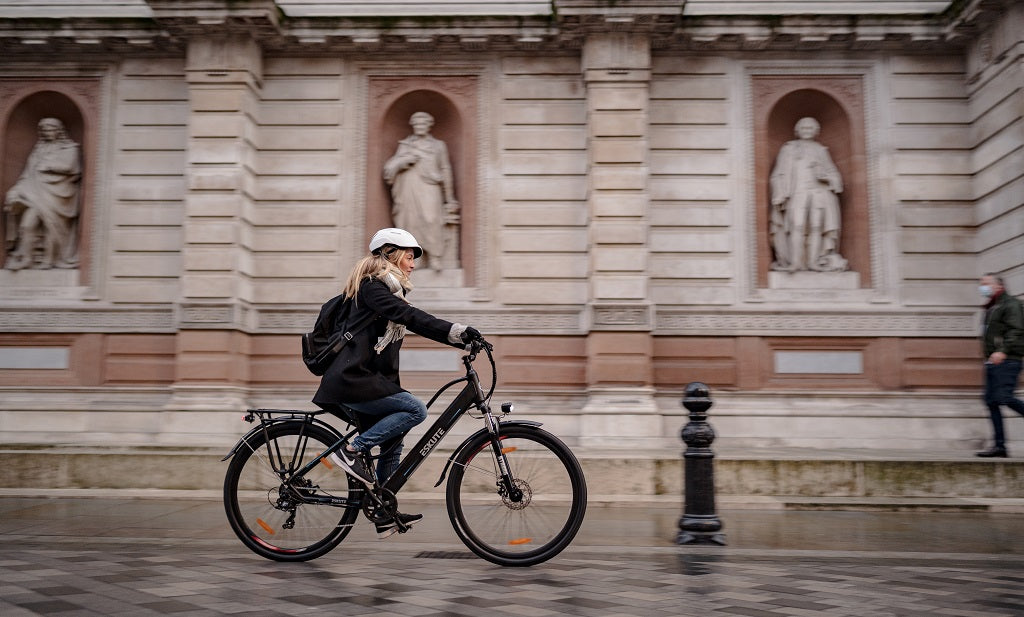Navigation
The UK residents that have shifted to E-bikes as a means of transport have experienced a complete transformation in their commute. Electric bike has opened the doors of easy traveling and traffic-free routes to people of all ages. The option to use an electrical assist while bicycling allows you to travel uphill without the added physical stress.
In Europe, E-bikes are incredibly popular and this is partly due to the advances in electric bike technology. Manufacturers have been able to introduce lighter batteries and powerful motors that produce seamless electrical assist. Sales are increasing rapidly, and the demand for these bikes is slowly increasing across the globe.

From Eskute Voyager Mountain Electric Bike
You can now see them being chosen by cycle couriers, commuters, delivery firms, and more. For urban commuting, it is much more cost-effective to have an E-bike than it is to use public transport. Not only is it cheaper, but it is also a more eco-friendly option, and makes for good exercise. Overall, it is a more accessible and enjoyable option for people.
The mayor of London plans to introduce policies that encourage more people to use E-bikes as a part of the global mission of reducing carbon emissions. City planners believe that E-bikes are the future of urban transport.
Evidently, the average person who uses an E-bike can travel much further on their average journey. However, for many people, shifting to electric bikes raises plenty of questions regarding its legality, licensing, taxes, insurance, and other regulatory nuances. Many still believe that electric bikes are illegal in the UK.
Difference between a regular pushbike and E-bike
The difference between a pushbike and an electric bike is not vast, and for this reason, they fall under similar legislative sanctions. On an electric bike, you still have everything that you can find on a regular bike. Nonetheless, you get to enjoy the bonus of the pedal-assist motor.
An electric bike is equipped with a pedal to assist the motor, a battery that powers the motor, and a head unit in the handlebar, which allows you to control the power output. A mid-mounted motor on a pedal-assist bike is the preferable option because they offer more balance to the rider and provide more torque. They are generally the choice for off-road riding and hilly adventures.
UK Laws on Electric Bikes
According to the UK government’s websites, it is permissible to ride an E-bike as long as you are 14 years of age or older and as long as the electric bike complies with particular requirements. The website further goes on to declare electric bikes as EAPCs, which is short for electrically assisted pedal cycles.

If your E-bike abides by the requirements of the government, then you can ride it without any licensing, insurance, or taxes. This is only possible as long as your electric bike is classed under the government’s rule of a pedal bike. The EU stipulates under the EN15194 law that the bike cannot go faster than 15.5 miles an hour, or in other metrics, 25 kilometers an hour.
Since the speed is limited, it also means that the power output from the motor cannot be more than 250 watts. These requirements are a reflection of the European standards of what contributes to an E-bike. All the major electric bike manufacturers build their bikes to European standards.
If your E-bike’s motor is capable of going over the required speed limit and your motor produces more than 250 watts, then the bike would no longer be classified under the EAPC. It would instead come under the motorcycle laws and will require you to need a license. Your electric bike will then also be subject to UK taxation and insurance. Additionally, you will also be required to wear a full motorcycle gear and helmet. The laws also only allow EAPCs on cycle paths and other platforms where cycle paths are allowed.
What makes an E-bike UK legal?
Firstly, the electric bike needs to have pedals that help propel it forward so that it can be classified as a legal means of transport. Another requirement, as discussed above is the maximum power of 250 watts. Keep in mind that this is a nominal power requirement so the bike can peak higher but must come back down to the 250 watts average.
The bike can only be assisted up to 25 km/h. It does not mean that you cannot ride the bike faster than this speed limit because how quickly you can go depends on how fast you pedal after your ebike reaches the limit of 25 km/h. You will notice that the bike will go faster than this average speed in many occurrences. For instance, when you use the electric assist on a downhill slope or use your pedal power along with the motor to push it further than the average speed limit.
UK laws do not allow any electric bike with twist-and-go throttle. A throttle assist allows users to thrust the bike forward using the turning motion on the handlebar.
The UK only permits electric bikes that have a pedal-assist motor. A pedal-assist motor or a mid-drive motor is mounted between the two pedals and acts as an electrical aid to the pedaling. Unlike the hub-drive electric bikes, in which the act of pedaling is completely eradicated, mid-drive motors require users to turn the pedal to initiate the electrical assist.
If you are 14 or above, and your bike meets all the above conditions, then your electric bike is classed in the same way as a normal bicycle. UK legal means that you have a significant amount of freedom when using the electric bike. It is worth pointing out that high-speed bikes are not considered in the UK as standard electric bikes. They fall into another category of speed pedal leg.
The speed pedal leg category refers to riding a bike that will propel you up to 28 miles an hour or 45 kilometers an hour. Since this type of bike falls under a speed pedal leg category, you need to have it registered into the L1 category to ride it in public spaces.

From Eskute electric bike factory
At this point, you also need to have a number plate, tax the motorcycle, insure it, and have a license for it. Overall, it takes much of the freedom away from the electric bike experience, and you are far more restricted when riding this type of bike under the regulatory system.
Electric Bike Insurance – Do you need it?
E-bike insurance is not a necessity by any means, but manufacturers and other experts strongly advise users to get the insurance. Taking up an insurance policy can protect you against theft, damage, and other faults that require covering.
Can home insurance cover your electric bike?
This typically varies with your home insurance provider. Most providers do not cover the cost of electric bikes. This is especially because they are high-ticket items. Even if they do, they will normally do that within the confines of your own home. If they cover your electric bike outside of your home, the options are very limited.
How much does Electric Bike Insurance Cost in the UK?
If you reference pedalsure, (an electric bike insurance provider), the cost of insurance for a bike priced at 3000 pounds will cost you roughly 15 pounds a month. This will annually come to a figure of about 180 pounds. This is a small price to pay when you consider the average replacement and repair costs of an E-bike.
How much E-bike coverage should you get?
Most insurance will provide coverage for any electric bike that ranges in worth, from 400 pounds right up to 15,000 pounds. You also get coverage for cycling accessories.
Theft and damage
Insurance companies will cover you against theft and damage. This means that you will be covered if a perpetrator steals your bike unknowingly and also if they damage or vandalize it. This coverage also includes any unforeseen or unintentional damage to your electric bike.
Injury
Insurance also covers you against personal injury. This means that if you hurt yourself while riding your bike, you will be covered for it by the insurance. Another similar coverage plan involves the public liability cover. Liability comes in a separate product, and it covers you if you injure someone else and cause damage to their property.
Overseas coverage
Overseas coverage involves traveling across different countries using the E-bike. The insurance company takes responsibility for any theft or accidental damage in a foreign country and is usually limited to a certain number of days.
Loss of earnings
Loss of earnings is situational coverage, and many insurance plans in the UK provide this type of coverage. It functions if you are injured as a result of a bicycle accident, and the injury is preventing you from going to work. In this instance, E-bike insurance can cover you with weekly payments until you can work again.
Replacement
Any e-bike insurance will help you get a new bike if it undergoes permanent damage or theft. In this instance, all you have to do is email the claims department. They will then send you a claims form to fill and return.
The insurance company will also require supporting documents for the E-bike. Upon reviewing the claims form and documents, they will provide users with a brand new electric bike, considering that all requirements are met.
If the insurance cannot replace and repair, they are likely to settle for a cash payment. The insurance company usually requires users to send photos of the damage. A supplier reviews these photos and assesses the damage.
Upon inspection, if the supplier believes that they can repair the bike, then they will collect the bike directly for further inspection. After the assessment, the supplier will then send a repair report to the E-bike insurance provider.
Gray Areas and Uncertainties in the UK E-bike Laws
Even though there are lesser gray areas than before, and the UK electric bike laws are well defined, many influencers of the E-bike industry have differences in opinion. For instance, James Fitzgerald, the founder of the famous retail store, “Just eBike,” believes that there is a ten percent margin on the limited speed requirements that few people know about.
Other E-bike retail owners claim that they have never heard of this margin and believe that it does not exist in the eyes of the law. Peter Eland, a technical manager and representative of the industry says that the 10 percent margin was allowed according to the EU law. However, after Brexit, the new legislation for electric bicycles did not mention this margin. This makes the law questionable according to current standards.
Is it easy to tell whether an E-bike is non-compliant with the UK regulations?
Since most of the E-bikes that you find at retail stores across the UK are built according to EU standards, this means that they will have to comply with the regulations and come with a sticker or CE conformity mark. This mark proves that the electric bike has undergone the relevant tests and is equipped within a normal bicycle's legal confines and framework. E-bikes, therefore, need to be fitted with a plate or sticker which explains the details about the manufacturer's name, speed, power output, type of motor, and more.
Final Thoughts
In the UK, legislation regarding electric bikes is very friendly. Insurance is also reasonable if you consider the repair and replacement costs that you spend in the entirety of the year. If you want to purchase an E-bike, make sure that you find the CE sticker on the bike to verify whether it has legal qualities. You can usually find this sticker at the back of the E-bike frame.
Click to know Important Electric Bike UK Law You Should Learn in 2022.










7 comments
Mr Leslie Briddon
The throttle ‘law’ mentioned is misleading. Bicycles prior to 2016 could be built and sold with throttles that needed no pedalling and went upto 15mph.(possibly 12mph in some years)
a new bike (as of 2023) can be sold with a throttle that only goes to 3.7mph without pedalling (this is ‘walking assist’ mode or on some bikes activated as assistance level 0) – once pedalling has commenced the throttle may work upto 15mph and this is the category of TG-EAPC. (T&Geapc)
Andrew
You apparently can convert an existing bike, which has been used on the road (so not brand new) to twist-and-go (throttle) as long as it meets the 250W and 15.5mph limits. This was highlighted on the following page:
https://www.pedelecs.co.uk/dft-pedal-cycles-converted-twist-go-exempt-type-approval/
and I emailed the DFT to conirm that the article was correct, to which they replied that it was.
For simple commuting then there are several kits around that should suffice with a hub motor, and for a mid-drive kit the new CYC Photon looks very interesting, and they now produce an EN15194 compliant version of their controller – as any controller with the ability to switch to a higher power mode renders it non-compliant (i.e. having a street legal mode and a race mode is not legal in the UK).
Larry White
The police don’t care. I live on a street with a posted 20 mile an hour speed limit and the cars go by at 30,40,50 and 60 miles an hour.
I told to a copper that was walking by my house about the speeding. I was told they know about it but they couldn’t do anything about it.
Neil Winstanley
I have a leg injury but would like to ride an Ebike to go out in the fresh air. I can’t get an Ebike with a throttle in the U.K. to allow me to get out and about. This is discriminatory against injured and disabled people and is possibly the dumbest law I have come across
Chris Griffith
A few errors here
There is no requirement in the UK to wear any protective motorcycle clothing or equipment other than a suitably approved helmet.
You state that you can travel faster than the 25Kph limit with pedal assist down hill or using your own power alongside the assist to travel faster than the legal limit. This is untrue, any legal e-bike will stop assisting once the 25Kph limit has been reached and to travel any faster will require your power alone or a bit of help from gravity!
And a small typo where you state a monthly insurance cost of £15 adds up to an annual cost of £170 a month…..
Leave a comment
This site is protected by hCaptcha and the hCaptcha Privacy Policy and Terms of Service apply.